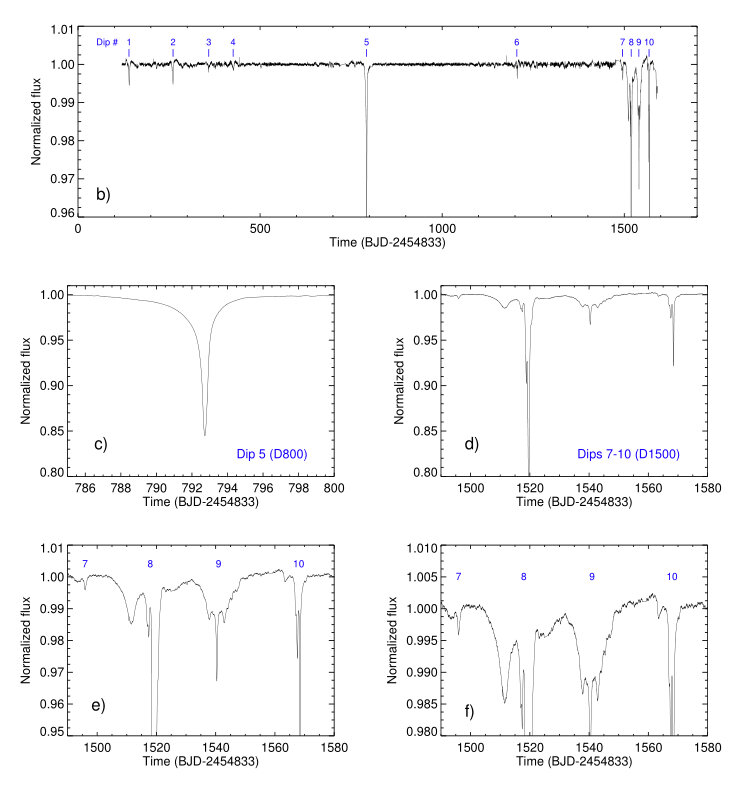nivek
As Above So Below
It’s a dimming star. It’s an alien megastructure. It’s a star being blocked by a giant planet. It’s a star eating its own planets. It’s Tabby’s Star (KIC 8462852), the fluctuating orb in the constellation Cygnus that has defied explanations for its periodic 22% changes in brightness since they were brought to light by astronomer Tabetha S. Boyajian.
Her 2015 paper “Where’s the Flux?”, prompted the star to get a nice nickname and a Kickstarter fund-raising campaign that raised over $100,000 to buy one year of telescope time on the Las Cumbres Observatory Global Telescope Network to monitor it.
The watching began in March 2016 and ended in December 2017.
Was the money well spent?

In her new report to be published in The Astrophysical Journal Letters and covered by EurekAlert, Boyajian reveals that her star dimmed in May 2017 and telescopes around the world turned and faced the strange. Seemingly knowing it was being watched, Tabby’s Star fluxed four more times before moving out of range.
In the tradition of Tabby, the team gave the fluxes nicknames: Elsie, Celeste, Scara Brae and Angkor. And, in the hopes that they might find a Dyson sphere being built around it, they searched the data from both their scans and previous ones from the Kepler telescope and focused on light wavelengths, knowing that a giant solid object would block all wavelengths.
Did Tabby and her fellow fluxers find a Dyson?
That blue made the team blue, as it indicates that what’s blocking Tabby is not a solid but more like a cosmic dust cloud. It’s a discovery that’s nothing to sneeze at but not as exciting as an alien fuel collector – no calls from Tom DeLonge on this one.
Unless … there’s something strange about the cosmic dust. The astronomers found that the particles are extremely small – smaller than cigarette smoke particles – and extremely cold, meaning they’re much farther away from the star than expected.
Finally, there’s still no regularity or predictability to it, which would be expected from a cloud in orbit around a star. That irregularity could indicate that the cloud is from a catastrophic event that may still be taking place.
Did the aliens blow up the Dyson structure when they found out we were watching?
New Theory on Dimming of Tabby’s Star is Something to Sneeze At
Her 2015 paper “Where’s the Flux?”, prompted the star to get a nice nickname and a Kickstarter fund-raising campaign that raised over $100,000 to buy one year of telescope time on the Las Cumbres Observatory Global Telescope Network to monitor it.
The watching began in March 2016 and ended in December 2017.
Was the money well spent?

In her new report to be published in The Astrophysical Journal Letters and covered by EurekAlert, Boyajian reveals that her star dimmed in May 2017 and telescopes around the world turned and faced the strange. Seemingly knowing it was being watched, Tabby’s Star fluxed four more times before moving out of range.
In the tradition of Tabby, the team gave the fluxes nicknames: Elsie, Celeste, Scara Brae and Angkor. And, in the hopes that they might find a Dyson sphere being built around it, they searched the data from both their scans and previous ones from the Kepler telescope and focused on light wavelengths, knowing that a giant solid object would block all wavelengths.
Did Tabby and her fellow fluxers find a Dyson?
If you imagine you have some light source and a planet—which is an opaque object—goes in front of it, it will block blue light just as much as it would the red light. What we’re seeing for this star is that the drop in the star’s brightness is much greater in the blue than it is in the red.
That blue made the team blue, as it indicates that what’s blocking Tabby is not a solid but more like a cosmic dust cloud. It’s a discovery that’s nothing to sneeze at but not as exciting as an alien fuel collector – no calls from Tom DeLonge on this one.
Unless … there’s something strange about the cosmic dust. The astronomers found that the particles are extremely small – smaller than cigarette smoke particles – and extremely cold, meaning they’re much farther away from the star than expected.
Finally, there’s still no regularity or predictability to it, which would be expected from a cloud in orbit around a star. That irregularity could indicate that the cloud is from a catastrophic event that may still be taking place.
Did the aliens blow up the Dyson structure when they found out we were watching?
New Theory on Dimming of Tabby’s Star is Something to Sneeze At

